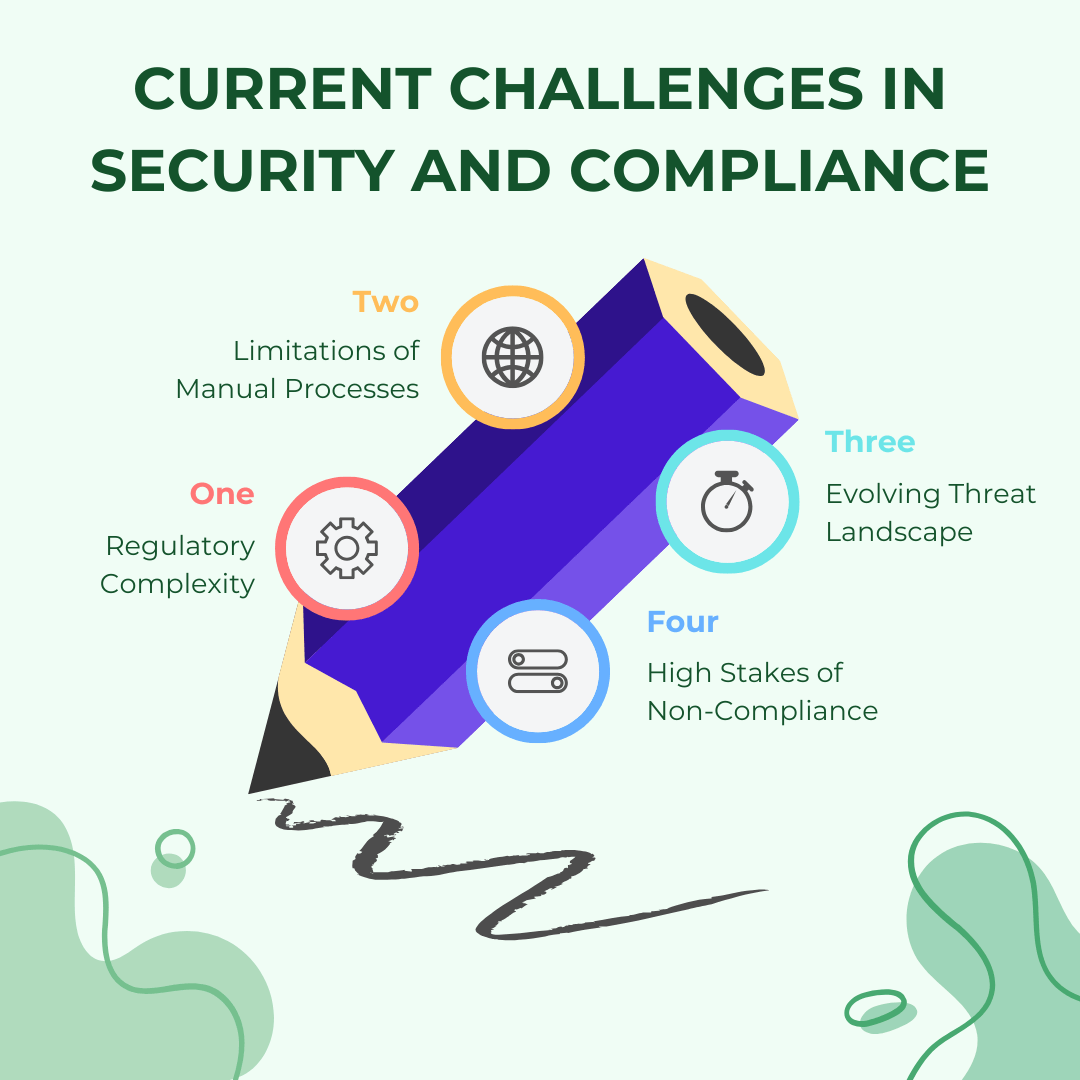Introduction
Managing security and compliance in today’s digital landscape is an overwhelming task, often leading to costly errors when handled manually. As regulatory demands grow more complex, businesses risk significant penalties and data breaches.
Automation offers a solution, streamlining these processes to ensure consistent adherence to regulations while reducing human error. By integrating automation into security and compliance, companies can safeguard their operations and focus on growth, rather than navigating the intricate maze of compliance requirements.
Current Challenges in Security and Compliance
Maintaining security and compliance has become increasingly challenging in today’s fast-paced digital world. Businesses face the daunting task of adhering to a growing number of regulations, typically spanning multiple regions and industries. The complexity of these regulations can overwhelm teams, leading to errors and lapses in compliance.
Manual processes are particularly vulnerable, as they’re prone to human error, time-consuming, and difficult to scale. Additionally, the rapid pace of technological change means that staying updated with the latest security threats and compliance requirements is a continuous battle. The risk of fines, reputational damage, and operational disruption is ever-present, making the need for more efficient solutions critical.
These challenges highlight the necessity for businesses to seek out innovative ways to manage security and compliance. This paves the way for automation to step in as a vital tool for ensuring accuracy, efficiency, and peace of mind in an increasingly complex environment.

The Evolution of Security and Compliance Practices
The evolution of security and compliance practices reflects the growing complexity of the digital landscape. Initially, businesses relied on basic manual processes to manage compliance, which were sufficient when regulations were fewer and less intricate.
However, as technology advanced and cyber threats became more sophisticated, these manual methods quickly became outdated. The increasing volume of data, coupled with stringent regulatory requirements, necessitated a more robust approach.
This led to the adoption of digital tools and eventually to automation, which now plays a critical role in ensuring continuous compliance and proactive security measures. Automation not only streamlines processes but also enables businesses to stay ahead of evolving threats and regulations, marking a significant shift from reactive to proactive management of security and compliance.
Understanding Automation in Security and Compliance
Automation in security and compliance refers to the use of advanced technologies to streamline and enhance the processes that protect businesses from threats and ensure adherence to regulations. Automation tools can handle repetitive tasks such as monitoring, reporting, and auditing with greater speed and accuracy than manual methods.
These tools integrate with existing systems to continuously track compliance, detect potential security risks, and automatically enforce security policies. By reducing human intervention, automation minimizes errors, enhances efficiency, and ensures that compliance measures are consistently applied across the organization.
Benefits of Automation in Security and Compliance
Automation in security and compliance offers numerous benefits that can transform how businesses operate. Firstly, it enhances efficiency by automating repetitive tasks like monitoring, reporting, and auditing, which reduces the time and effort required for manual processes.
Secondly, automation significantly improves accuracy, minimizing the risk of human error and ensuring that compliance measures are consistently applied across all operations. It also boosts security by enabling real-time threat detection and response, allowing businesses to proactively address potential risks.
Lastly, automation helps reduce costs by streamlining processes, reducing the need for extensive manual oversight, and avoiding penalties associated with non-compliance.
Implementing Automation in Your Business
Introducing automation into your business demands a thoughtful strategy to ensure a smooth transition and optimize its benefits. Start by identifying key areas where automation can have the most impact, such as compliance monitoring, threat detection, and reporting.
Next, select automation tools that align with your specific business needs and integrate effortlessly with your current systems. It's essential to involve stakeholders in the process, providing training and support to ensure a successful implementation. Regularly review and adjust your automation strategy to stay ahead of evolving security threats and regulatory requirements.
Case Studies of Successful Automation
Case studies of successful automation in security and compliance highlight the transformative impact on businesses across various industries.
For example, a financial institution implemented automated compliance monitoring, resulting in a 50% reduction in audit preparation time and a significant decrease in regulatory fines.
Another case involved a healthcare provider using automation to manage patient data security, leading to improved data accuracy and faster breach detection.
These examples demonstrate how automation not only enhances efficiency but also strengthens security and ensures continuous compliance, providing measurable benefits across operations.
Future Trends in Security and Compliance Automation
The future of security and compliance automation is poised to be shaped by emerging technologies and evolving business needs.
Artificial intelligence (AI) and machine learning (ML) are expected to play a pivotal role in predictive threat detection, allowing businesses to anticipate and counteract risks before they materialize. Blockchain technology may also become more prevalent, providing enhanced transparency and security for compliance records.
Additionally, as regulations continue to evolve, automation tools will likely become more adaptive, enabling businesses to stay compliant in real-time with minimal manual intervention.
The integration of these advanced technologies will help organizations stay ahead of threats and regulatory changes, ensuring that their security and compliance frameworks are future-proof.
Common Misconceptions and Challenges
When it comes to automating security and compliance, several misconceptions and challenges can hinder adoption.
A common misconception is that automation will lead to significant job losses, overlooking how automation can free up employees for more strategic tasks.
Another challenge is the perceived complexity and cost of implementing automation, which can deter businesses from embracing these technologies.
However, with the right approach, these barriers can be overcome, allowing companies to benefit from increased efficiency, accuracy, and compliance without sacrificing their workforce or budget.
Key Takeaways
- Automation Enhances Efficiency: Automating security and compliance processes reduces manual labor and improves accuracy.
- Proactive Risk Management: Automation enables real-time threat detection and response, mitigating risks before they escalate.
- Cost Savings: By streamlining operations and minimizing errors, automation helps avoid costly fines and reduces operational expenses.
- Scalability: Automation allows businesses to easily adapt to changing regulations and scale operations efficiently.
- Future-Proofing: Emerging technologies like AI and blockchain will further enhance automation’s role in security and compliance.
Conclusion
In conclusion, automation in security and compliance is not just a trend but a necessary evolution for modern businesses. By automating these processes, companies can significantly reduce manual errors, improve efficiency, and ensure continuous adherence to regulations.
The integration of advanced technologies like AI and machine learning further enhances these benefits, allowing businesses to stay ahead of emerging threats and evolving regulations. Embracing automation not only safeguards operations but also positions businesses for sustained growth in an increasingly complex regulatory landscape.

